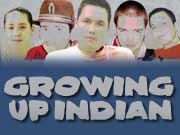| |||||||||||||||||||||||||||||||||||||||
What they say: From the Houghton Mifflin Online Study Service, this Encyclopedia of North American Indians article outlines the U.S. Government's practice of removing Indian children from their homes and placing them in residential boarding schools at the end of the 19th Century.
Why visit: University of Minnesota professor Brenda Child describes the sometimes disastrous effects of the misguided federal policy designed to promote the assimilation of American Indians into mainstream American culture. The philosophy of "Kill the Indian and save the man" resulted in a disruption of Native American family structure and community that underpins many of the problems facing Indian communities today.
What they say: Native Vision's year-round initiative has been designed to promote three major areas of well-being for Native children and families: 1) Healthy Minds, 2) Healthy Bodies, and 3) Healthy Families. Each program area involves a variety of school, community and home-based outreach.
Why visit: Every year, Native Vision accepts applications for three $1,000 scholarships that can be used for college tuition and expenses. Applications are accepted between March-May of each year and the scholarships are awarded in June at each Native Vision camp.
Indian Child Welfare Glossary (pdf)
What they say: The Indian Child Welfare glossary is compiled to accompany the ICWA/Child Protective Services (CPS) Flow Chart. The glossary represents words that are commonly used in Indian child welfare and in situations where the Indian Child Welfare Act is applied.
Why visit: Scroll down through the flow chart for a wide-ranging set of terms and concepts that help unravel the official language of child welfare as it applies to Native American children.
Cornerstone Children's Defense Fund (pdf)
What they say: The National Collaboration to Promote Permanency through Subsidized Guardianship is Cornerstone's multi-year initiative designed to provide technical assistance and educational materials to federal, state and local audiences interested in finding a safe, permanent and loving home for abused and neglected children.
Why visit: Go to the section on cultural perspectives for insight into tribal traditions of "customary adoption," that that provide permanent parent-child relationships with someone other than the birth parents without severing the child's kinship with the birth parents.
Office of Juvenile Justice and Delinquency Prevention
What they say: In the past few years, a growing concern about crime, delinquency, and gang activity in Indian country has emerged. Previous research shows that much of the gang activity seems to be an expression of youthful experimentation with gang identity and that a strained social environment, the appeal of popular culture surrounding gang activity, and a lack of positive activities for youth contribute to the American Indian youth gang phenomenon.
Why visit: The findings of this study illustrate gang activity in Indian country and what interventions and strategies can be used to respond to the problem.
Risk Factors for Substance Abuse
What they say: Recent reports have shown higher rates of substance use among American Indians or Alaska Natives, compared with persons from other racial/ethnic groups. This report looks at risk and protective factors for substance use among 46,310 respondents aged 12 to 17, comparing American Indian or Alaska Native youths with youths among all other racial/ethnic groups combined.
Why visit: Comprehensive data on the risk factors for substance abuse among American Indian children.
The People's Institute for Survival and Beyond
What they say: The People's Institute was created to develop more analytical, culturally-rooted and effective community organizers. The People's Institute is recognized as one of the foremost anti-racism training and organizing institutions in the nation. In a 2002 Aspen Institute survey of 11 top racial justice organizations, five credited The People's Institute with having the most effective anti-racist analysis.
Why visit: Extensive resources for those working organizing and teaching to combat racism.
What they say: White Bison offers sobriety, recovery, addictions prevention, and wellness/Wellbriety learning resources to the Native American community nationwide. White Bison's mission is to assist in bringing 100 Native American communities into healing by 2010. This mission is being realized by means of the many Wellbriety resources, Wellbriety conferences, specialized community training events, Wellbriety coalitions, and the popular grassroots Firestarters circles of recovery groups across the nation.
Why visit: This Web site offers a variety of programs and resources designed to foster sobriety, recovery and strengthen family and community ties.




